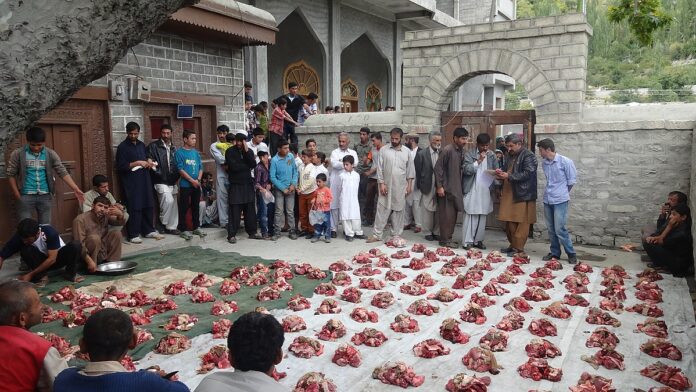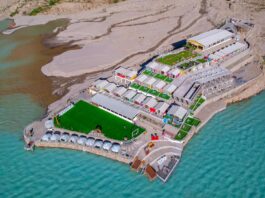Introduction:
Eid ul Adha, also known as the Festival of Sacrifice, is an important religious celebration for Muslims worldwide. It commemorates the willingness of Prophet Ibrahim (Abraham) to sacrifice his son as an act of obedience to Allah (God). In Pakistan, Eid ul Adha holds great significance and is celebrated with immense fervor and enthusiasm. This article aims to shed light on the different Qurbani (sacrifice) systems in Pakistan, with a focus on the unique practices in the picturesque region of Hunza, situated in Gilgit-Baltistan.
The Tradition of Qurbani in Pakistan:
Qurbani is an integral part of Eid ul Adha, symbolizing obedience, selflessness, and the act of giving back to the community. Muslims perform Qurbani by sacrificing animals, such as goats, sheep, cows, or camels, as a reflection of Prophet Ibrahim’s devotion. The meat from the sacrifice is divided into three parts: one for personal consumption, one for relatives and friends, and one for the less fortunate.
Qurbani in Gilgit-Baltistan:
Gilgit-Baltistan, situated in the northern areas of Pakistan, including the scenic Hunza valley, has its own distinct traditions and customs when it comes to celebrating Eid ul Adha and performing Qurbani. The region is known for its breathtaking landscapes and rich cultural heritage, which reflects in their unique approach to Qurbani.
The Wakhi Community:
One of the prominent communities in Hunza, particularly known for their distinct Qurbani practices, is the Wakhi community. The Wakhi people are linguistically and culturally linked to Tajikistan, Afghanistan, and China. Their Qurbani ritual includes offering the sacrifice at the local mosque, where the community gathers for prayers and a sermon by the religious leader.
Emphasis on Sharing and Community Spirit:
In Hunza, the spirit of sharing and community is paramount during Eid ul Adha. The Wakhi people ensure that the meat from the Qurbani is divided into equal portions and distributed among the community members, especially those who are less fortunate. This act of generosity and solidarity strengthens the social fabric of the region and promotes harmony.
The Cultural Significance of Qurbani in Gilgit-Baltistan:
Qurbani in Gilgit-Baltistan is not just a religious obligation but also deeply rooted in the region’s cultural fabric. It serves as an opportunity for families to come together, strengthen bonds, and share a festive meal. The celebrations often include traditional music, dance, and storytelling, further enhancing the joyous atmosphere.
Sustainability and Animal Welfare:
In recent years, there has been a growing emphasis on sustainable and ethical practices during Qurbani. Organizations and individuals in Gilgit-Baltistan, including Hunza, have taken steps to ensure the well-being and humane treatment of animals during the sacrifice. Awareness campaigns promote responsible Qurbani practices, such as ensuring proper animal nutrition, cleanliness, and adherence to guidelines that minimize animal suffering.
Ganish Village: A Cultural Gem in Hunza, Gilgit-Baltistan
Ganish is a historic village nestled in the mesmerizing valley of Hunza, Gilgit-Baltistan. Known for its rich cultural heritage, Ganish offers a captivating glimpse into the traditions and customs of the region. The village is renowned for its architectural marvels, including centuries-old stone houses and unique cultural practices that are preserved to this day.
Qurbani in Ganish: A Blend of Faith and Tradition
In Ganish, the Qurbani ritual during Eid ul Adha is performed with deep religious devotion and cultural significance. The locals meticulously prepare for the occasion, ensuring that they adhere to the teachings of Islam while honoring their ancestral customs. This blend of faith and tradition makes Qurbani in Ganish a truly remarkable experience.
Emphasis on Community and Sharing:
Community cohesion and the spirit of sharing play a crucial role in Qurbani celebrations in Ganish. The villagers collaborate closely to organize the Qurbani process, which includes selecting healthy animals for sacrifice and coordinating the distribution of meat. The aim is to ensure that everyone, especially the less fortunate, has access to the sacrificial meat, fostering a sense of unity and compassion within the community.
Traditional Practices and Customs:
In Ganish, the Qurbani process begins with congregational prayers at the local mosque, where the community gathers to seek blessings and offer gratitude. Following the prayers, the designated individuals skilled in animal slaughter, known as “Zabbakh,” skillfully carry out the sacrifice. This practice holds deep-rooted cultural significance, passing down from generation to generation.
Preservation of Indigenous Breeds:
Hunza, including Ganish, takes pride in preserving indigenous livestock breeds. During Qurbani, the villagers often prioritize sacrificing animals of local breeds such as the Balti goat, Markhoor goat, and Cholistani cow. This preservation effort not only maintains the ecological balance but also supports the local economy and sustains traditional livestock husbandry practices.
A Harmonious Blend of Islamic Values and Cultural Heritage:
The Qurbani system in Ganish exemplifies the harmonious coexistence of Islamic values and local cultural heritage. While adhering to the religious obligations of Eid ul Adha, the villagers also showcase their unique customs, including traditional music, dance, and storytelling. This blending of faith and cultural expressions adds depth and richness to the celebrations.
Conclusion:
Eid ul Adha and the Qurbani ritual hold immense significance for Muslims across Pakistan, and Gilgit-Baltistan, specifically Hunza, showcases its unique cultural flavor in celebrating this important occasion. The community’s emphasis on sharing, unity, and sustainable practices during Qurbani reflects the essence of Islamic teachings. As we embrace diversity and continue to foster compassion and care for both animals and fellow human beings, the celebration of Eid ul Adha in Gilgit-Baltistan serves as a shining example for others to follow.
References:
“Eid al-Adha – Festival of Sacrifice.” Islamic Relief USA. Retrieved from https://irusa.org/eid-al-adha/
Hussain, I., et al. (2019). “Diversifying Mountain Agriculture: The Role of Wakhi Agro-Pastoralists in Hunza Valley.” Journal of Mountain Science, 16(4), 951-963.
Mustafa, G. (2021). “The Transformative Role of Music and Dance in Cultural Festivals: A Case Study of Hunza, Gilgit-Baltistan.” Journal of the Research Society of Pakistan, 58(1), 62-79.




